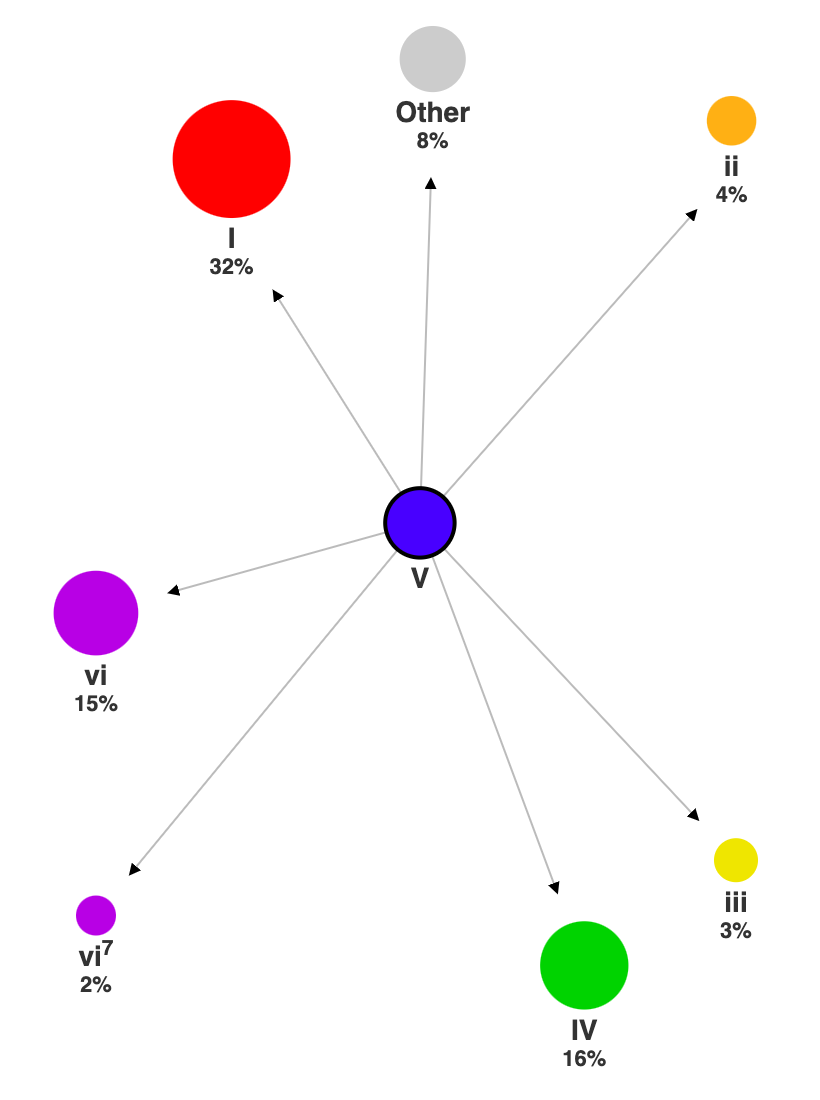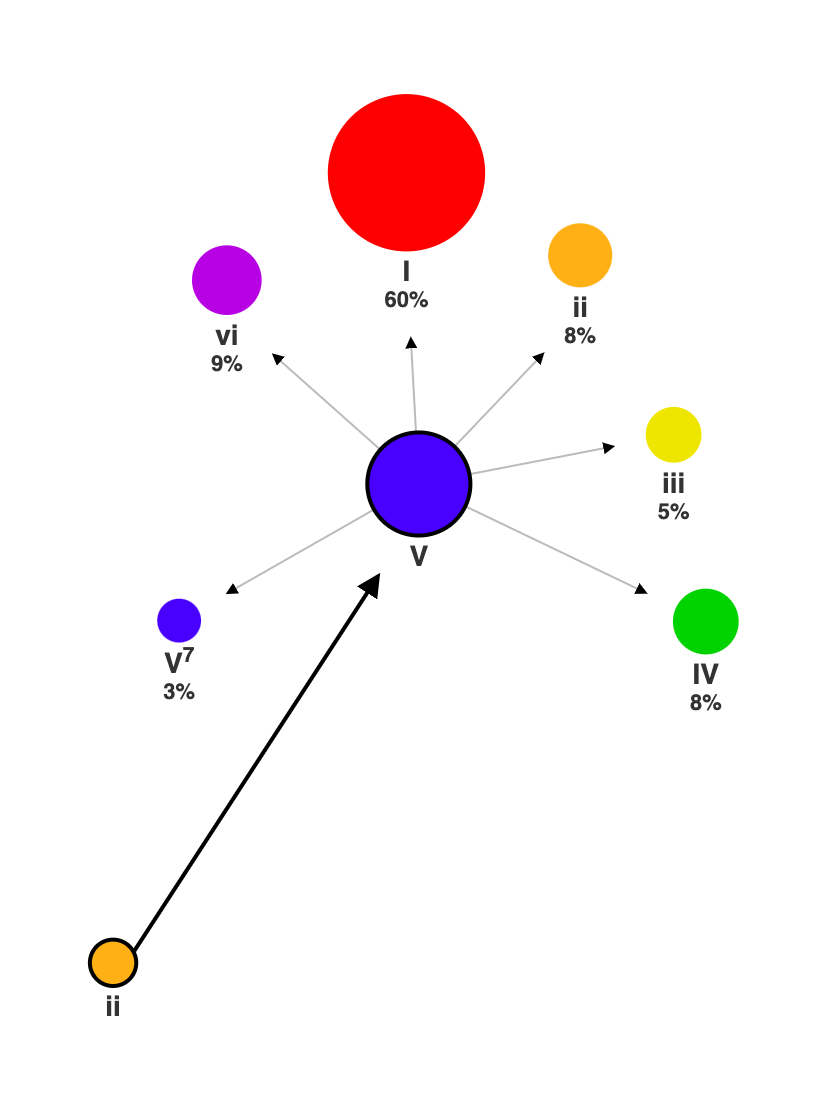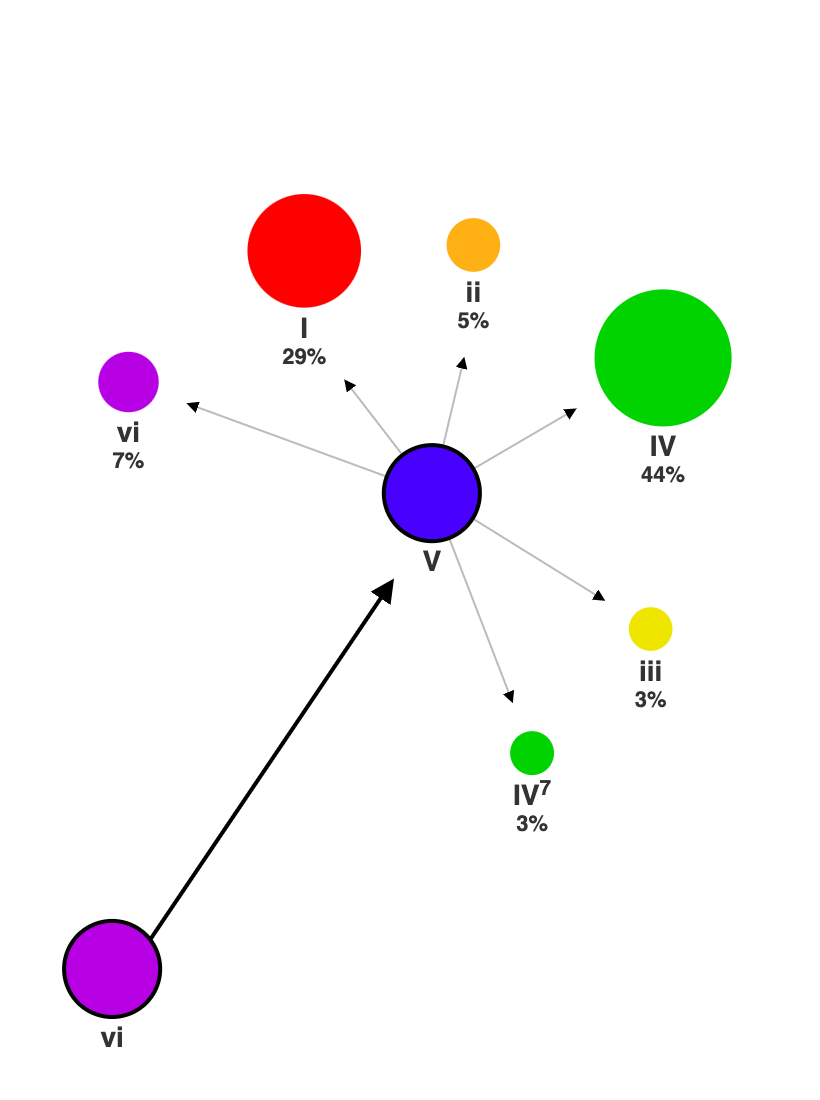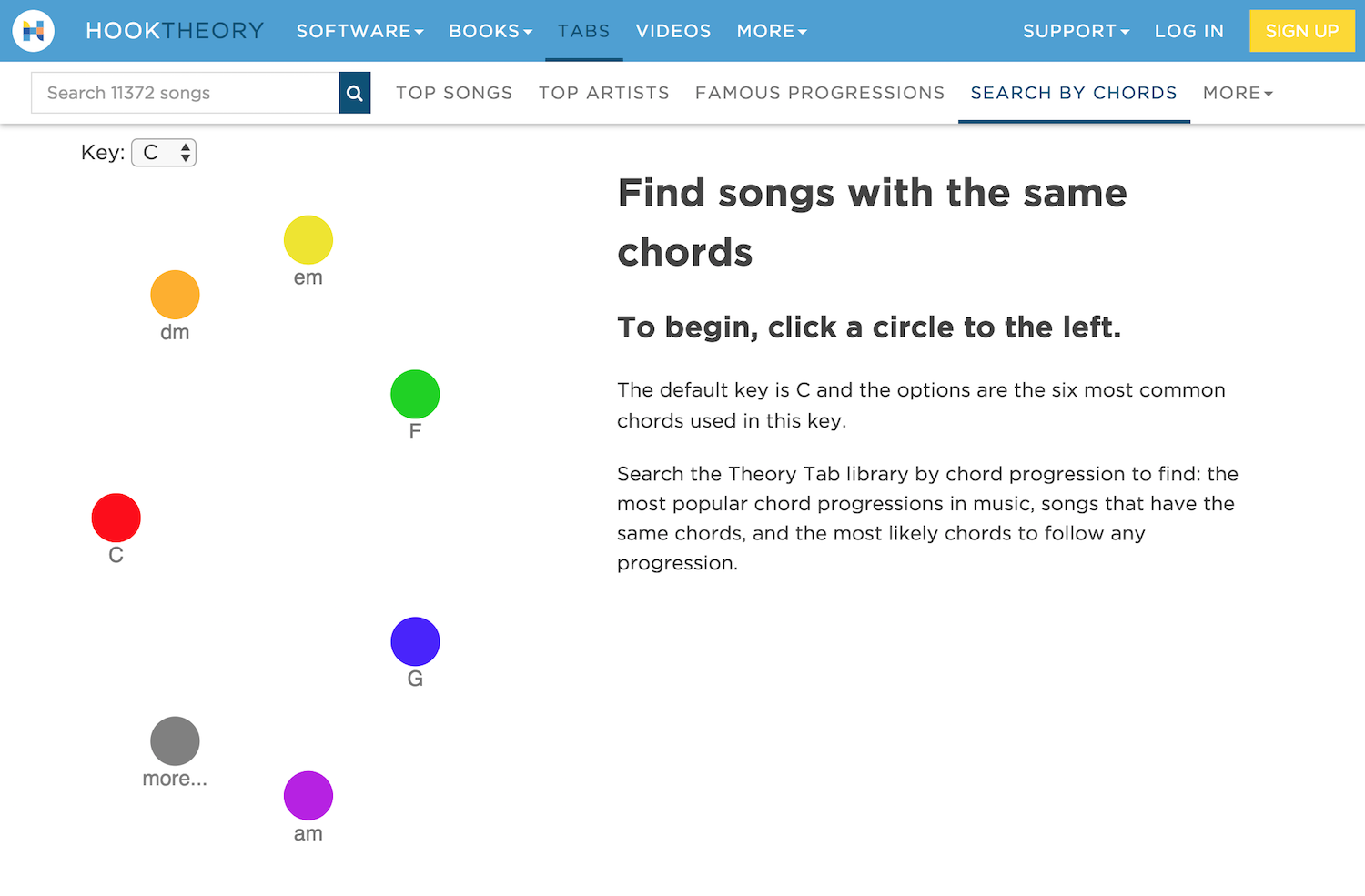Contents
1. Review of Nexus Systems
Now, up to this point, we have examined the characteristics of each nexus.
| Nexus | Features |
|---|---|
| 2▲2▼ | Gentle and smooth, yet rich in color |
| 5▲ | Clear driving force, characteristic |
| 5▼ | Clear driving force and easy to listen to |
| 3▲ | Minimal tone change, unique sense of floating up |
| 3▼ | Minimal tone change and stable |
Understanding the differences in the impressions allows you to create progressions that perfectly align with what you try to express. In general, downward progressions tend to create calm and stable developments, while upward progressions highlight distinctive characters.
Summary of “Former Prohibition”
The explanations of the “former prohibition” were divided into separate parts in previous sections, so let’s summarize them here.
There are two types of forbidden progressions: one is the pattern found in 2▼5▲3▼, which doesn’t follow the exemplary resolution of D functioning chords. And the other is within 3▲, involving “minor to major nexus within the same function.”
By summarizing in this way, you can reduce the burden of memorization. Upon closer examination, it becomes clear that IIIm is the trickiest one. According to traditional classical theory, its progression should be either IV or VIm, and nothing else.
The Rationale for Prohibition
The scientific basis for labeling these progressions as “forbidden” is quite limited. Ultimately, it comes down to the fact that they did not align with the sensibilities and musical styles of the people at the time when the theory was formed. These rules were shaped by statistics, or to be critical, it’s just a product of empirical rules formed on a case-by-case basis.
Of course, Western theorists came up with many hypotheses to prove that their “great Western theory” was a universal truth for all of humanity. However, they failed to provide definitive proof. On the contrary, recent studies of cultures that have not been exposed to Western music are increasingly casting doubt on claims of such universality.
Meanwhile, blues was born, electric guitars were born, synthesizers were born, turntables and samplers were born, and entirely new forms of music emerged. Progressions like V→IV, once considered “unpleasant,” have become increasingly prevalent among the general audience. This is what’s happening in reality.
In the history lesson in the introduction part you saw established “standards” were always broken by cutting-edge artists. The truth is, when music styles change, theory should change as well.
That’s why LMT encourages composing freely without being bound by such rules. Of course, freedom comes with responsibility, and that’s where the nexus system theory comes into play.
Upgrade to the Functional Chart
The functional chart introduced in the TDS functional harmony section can be upgraded with the nexus theory as shown below.
The seven arrows are the “one-way paths” and going back them violates the former prohibitions. As long as you don’t go against them, you can create progressions that no pedagogues will get furious😎
However, as genres continue to mix in the future, there will be fewer situations where you need to worry about it. But anyway now you can control how orthodox/heterodox a chord progression may sound from the viewpoint of traditional Western music theory, which helps your songwriting a lot!
2. Data Analysis
The “prohibited” progressions have gradually gained popularity over time, but it lacks persuasiveness without some statistical data, doesn’t it? So, let me introduce a bit of big data here.
This website has a database of chord progressions for 11,000 popular songs. By using sites like these, you can obtain statistical information about chord progressions.
About the Progression of V
Traditionally, V has been expected to progress to I, VIm, or IIIm, and IV and IIm are considered as “forbidden” or “irregular” progressions. But what’s the reality?
So, let’s set the key to “Rel” (=relative) and click on V chord, and you’ll see the percentage of its next progressions:
While I is indeed at 32%, IV, which was considered a forbidden D–S nexus, has gained a 16% ratio, almost equal to the progression to VIm, a proper D–T progression. When we combine the I, VI, and III chords, which can be seen as T family, it’s 52%, while the forbidden IV and IIm combined are at 20%.
Indeed, this data primarily represents American music, so it can’t be said to reflect all the trends in popular music. Nevertheless, it contains a variety of information that cannot be ignored. With over 1,000 songs as examples, it’s better to treat them as “example data” than to ignore them as exceptional cases.
Analyze on Your Own
Dealing with big data like this is a relatively recent development. Therefore, statements like “most songs start with T” or “1-6-2-5 is the most commonly used progression” from music theory books of yesteryears are, to put it bluntly, unsupported claims.
In the end, the most important indicator is the actual songs of the genre you’re working on. Analyzing it yourself is the only way forward.
3. Limits of Theory, and Abstraction
By the way, the nexus theory focused on the connection of just two chords, but when you consider a sequence of three chords, the discussion becomes even more complex. For example, interesting results are yielded regarding V when analyzing the connection of three chords, that is, what comes before V and after V.
 I : 32% / IV : 16%
I : 32% / IV : 16%
 I : 60% / IV : 8%
I : 60% / IV : 8%
 I : 29% / IV : 44%
I : 29% / IV : 44%
Do you understand what these three sets of data suggest? Firstly, if we look at just V alone, the progression to either I or IV is in a 2:1 ratio as mentioned earlier. However, if we narrow it down to cases where it progresses “from IIm to V,” the progression to I overwhelmingly increases. In contrast, when it’s “from VIm to V“, a significant number goes to IV, which is supposed to be prohibited! This shows how strongly contexts can influence the tendencies of chord progressions.
So, in reality, to thoroughly discuss chord progression trends, it’s insufficient to focus only on the connection of two chords; However, when it comes to 3-chord connections, there are 150 possible combinations, which is too numerous to explain. It goes beyond the limits of human memorization. In other words, we cannot fully theorize the complex world of music and have reduced its resolution to a level our minds can barely handle.
For instance, in physics class at school, you often see assumptions like “assuming no air resistance or friction.” Music theory is doing the same thing. The real world is too complex, so we simplify the complicated parts to make theory manageable.
When you take another look, in chord theory, there are many things that are “assumed not to exist.”
- Effects of context
- Music genres
- Listener’s music experience
- Instrument timbre
- Chord voicings
When you encounter phenomena in practice that cannot be explained well by theory, it’s often more useful to observe these excluded aspects rather than searching for more complex theories. The act of simplifying and removing elements is called “abstraction”. Theorization and abstraction are inseparable aspects of the same coin.
Keeping in mind that “music theory simplifies music” can prevent you from becoming a top-heavy armchair theorist who thinks that one can see everything about music through theory.
4. Conclusion
Well, the course of nexus theory in chapter I is coming to an end. It might seem like a lot of information, but as I mentioned at the beginning, you don’t need to memorize everything to move on with your songwriting. You can start by using chord progressions you just like and memorize them in your preferred order.
Furthermore, names and classifications are not essential. What the nexus theory wants to convey is simple—there are no rules in music. There are “control factors” such as root motion and chord quality, from which various musical ideas emerge. Once you understand this, you won’t need to memorize much; you’ll know what each progression brings to music.
Freedom on Songwriting
You have total freedom on songwriting. Every combination of chords creates various colors. Each nexus has its unique charm that cannot be replaced with another. Every chord progression has meaning. You don’t need to worry about whether a chord progression is “theoretically correct.” There’s no such thing as correct music from the start. The nexus theory is just a means to show that.
In this discussion we talked about the varying preferences across genres, but of course, you’re free to challenge and introduce something unconventional to a genre. Such attempts have been always made historically.
In fact, this mindset doesn’t go against authentic theory books. Barrie Nettles, who served as a lecturer at Berklee College of Music for over 30 years, even as the president of the college, recognizes the freedom of chord progressions.
Any diatonic chord may progress to any other diatonic chord. The control factor is in the relationship between the roots of the chords and the voice leading between chords.
Barrie Nettles “The Chord Scale Theory Jazz Harmony” (p.31)
The term “control factor” actually comes from this quote. In reality, the Berklee’s method, a kind of the founder of popular music theory, doesn’t impose any “rules” on chord progressions. The idea that music theory distinguishes between correct and incorrect music seems to be an outdated and exaggerated notion.
Of course, as you delve into advanced chords, you’ll encounter some difficult chords like “it’s better to follow this with that,” but at least within the realm of the six prime chords, you can connect chords freely. With as many genres as there are, there are standard progressions, so I hope you can build your “original nexus system” in your mind to express your own style.
So, in Chapter I, basic concepts such as “prime chords,” “Roman numeral analysis,” and “TDS” have been explained considerably. As you can see from what you’ve learned so far, even with just prime chords a deeply profound world opens up. When you add “quality changes” and “tensions” to the mix, it becomes even richer. That’s why, depending on the genre, the knowledge in chapter I might be sufficient. I hope you can dedicate yourself to firmly mastering these fundamentals without rushing ahead.
Summary
- The classical rules were born from the experiential rules of their respective genres, and new music genres come with new musical styles.
- Music theory is a partial abstraction of music, and there are always parts that have been ignored.
- Any connection is possible between prime chords, and the skill of controlling them is what is called “a good sense of music.”





